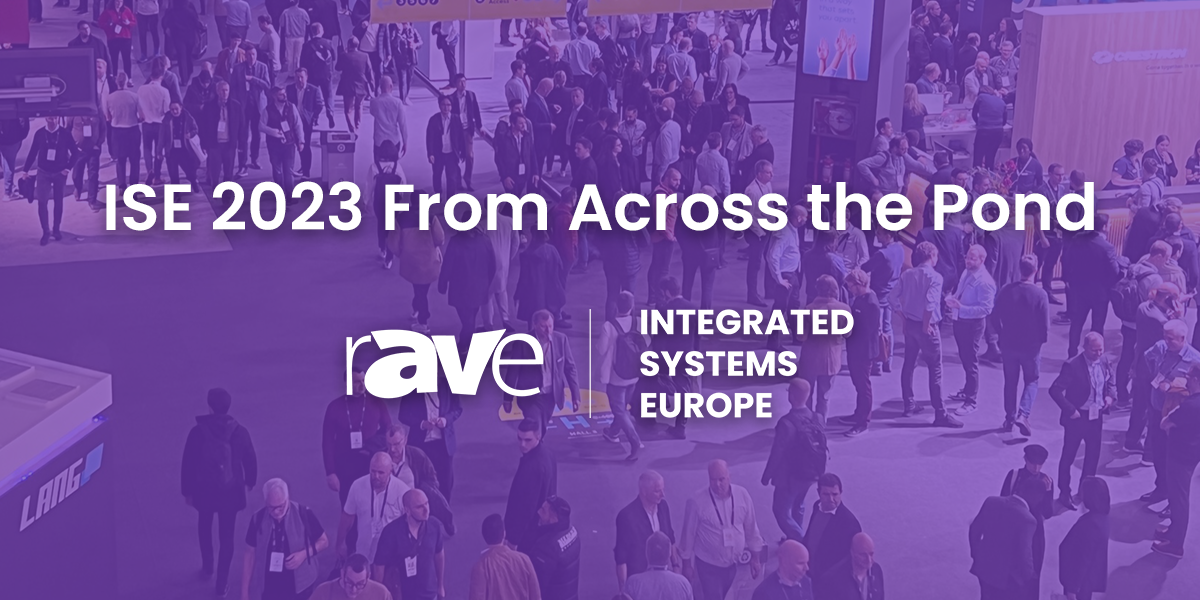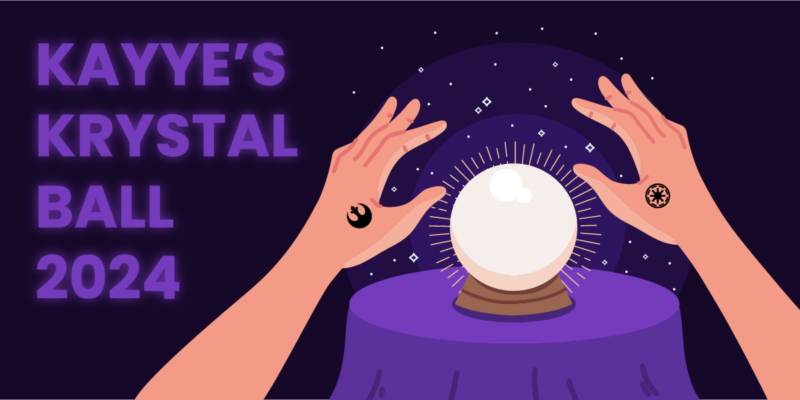ISE 2023 From Across the Pond: A Detailed, In-Depth Look at Trends From the Show

Welcome back to another installment of my reviews of a trade show I didn’t attend, in which I stay home in North Carolina and spend many, many hours watching (and titling and categorizing) every single product video that the rAVe videos shooters collected while roaming the floor of Integrated Systems Europe in Barcelona.
This year’s ISE 2023 in Barcelona was a doozy. Although numbers of exhibitors and total attendees haven’t returned to 2019 levels yet (1,300+ exhibitors and 81,286 total attendees in 2019 vs. 900+ exhibitors and 58,2017 attendees in 2023), the sentiment seemed to be that this was the first show that felt like the trade shows of old, way back before the pandemic. ISE did break numerous records — highest first-day attendance, highest number of first-time attendees and most square meters of exhibit space — now that the show is both less constrained by the Amsterdam RAI and COVID-19. rAVe shooters collected something like 1,900 product videos this year, and yes, I watched all of them.
Since I didn’t go to the show, I also didn’t really discuss the buzz on the show floor with anyone there or formulate opinions based on what other people thought or on what I heard in press conferences and events. Every insight I’ll talk about here is based exclusively on what was said in the videos recorded by the rAVe team. Here’s what I noticed.
dvLED Was Everywhere
If UCC was the dominant technology of the 2022 shows, direct-view LEDs are the it-product for 2023. They were everywhere, in almost every application. They were particularly noticeable in virtual production sets (considering this is a pretty small vertical for ProAV specialists) — both as a green-screen alternative for smaller production sets, and of course, as a backdrop replacement for on-site filming for TV shows and feature films.
Here are some links to some videos with just a few of the dvLED virtual sets on the show floor:
- ISE 2023: Mo-Sys Explains Virtual Production Technology Uses in Film Production at Alfalite Stand
- ISE 2023: Macroblock shows XR LED Display for Virtual Production + MBI5762 Driver
- ISE 2023: Pixotope Technologies Shows Off XR Virtual Mapping Solution for LED At Unilumin Group Booth
- ISE 2023: Absen Showcases Pixel Reality PR 2.5 for Virtual Production Solution With Matte Surface
- ISE 2023: NovaStar Tech Debuts xR Complete Virtual Production Solution
- ISE 2023: AOTO Demos Complete XR Studio Solution for Virtual Production With dvLED and Processing
Brompton Technology in particular showed how its extended bit depth technology and brightness control could be used for specific production applications:
dvLED was also demonstrated for use in immersive applications, including in one way I hadn’t seen before: using corners or curved screens to give a glasses-free 3D effect. Here are some examples:
- ISE 2023: Expromo Demos Deep-Impact 3D Content on Rental Screen
- ISE 2023: Recience Shows RE Series Modular dvLED for Immersive Display Applications
- ISE 2023: Gloshine Shows MV Series of Curved, Indoor dvLED for XR (Extended Reality) Applications
- ISE 2023: Dahua Technology Features Its dvLED Immersive Cube
- ISE 2023: RPG Shows dvLED Display in Immersive Application
This one from QSTECH demos the 3D effect most dramatically — even on the rAVe video, the panda really looks amazingly 3D:
Pixel pitches have narrowed further, with a couple 0.4-mm from Ledman and Unilumin and even a 0.3-mm pixel pitch from AOTO on the floor this year. There was also a 0.3mm from XL VISUAL, but it was for a spherical architectural display. These are primarily prototypes — the challenge with narrow pixel pitch dvLEDs isn’t as much in creating a single display for demonstration, but in (remotely affordable) production at scale because of yield.
I remember being amazed the first time I saw (in person) a dvLED with a pixel pitch sub-1mm, which I believe was Leyard’s 0.9mm prototype back in 2015/2016, around the time that COB (chip on board) became a new LED encapsulation method, allowing for breakthroughs in smaller pixel pitches. Pixel pitch is definitely a sexy spec (I’m just as grossed out to write that as you are to read it, but it is what it is), one that’s easy to focus on when attempting to compare the now-incomprehensible number of brands that sell dvLED displays, not to mention the many, many SKUs.
But dvLEDs present other challenges for close-range applications, mainly that They Don’t Like to Be Touched, and it looks like there has been lots of work on the robustness front. I saw many more GOB dvLEDs than I had in the past. GOB stands for “glue on board,” and it’s when the LED modules are covered with a protective, transparent substrate or epoxy (hence “glue”) that protects the fragile LEDs from harsher environments. More relevant to the narrow-pixel-pitch applications, the epoxy protects against human fingers and skin, which have oils that can damage traditional SMDs.
GOB has been around for awhile, but in the past it has had some serious downsides affecting picture quality. It’s hard to tell from our videos, but I hope that also means — given the number of manufacturers with GOB products — that the quality of the GOB displays have improved.
COB (chip on board) and flip-chip technology was also quite widespread. COB dvLEDs are inherently more robust than traditional SMDs because the packaging encapsulates the entire LED chip rather than just the individual diodes.
This all meant there were dvLED displays on the floor that were more robust, allowing for touch displays (not just via an overlay) and more flexibility with curvature than ever before.
Here are some dvLED videos to check out:
- ISE 2023: Ledman Demos Its Intelligent Meeting System with Interactive COB dvLED Display COB
- ISE 2023: Leder Opto Offers 1.9mm Fixed Installation Indoor Fixed Install GOB dvLED Display
- ISE 2023: One Display Demos Soft GOB Flexible dvLED Screen
- ISE 2023: Hisense Showcases the HAIO136 136″ dvLED All-In-One Display for Boardrooms
- ISE 2023: Zhongrun Optoelectronics Shows rAVe Its P1.88 Bendable dvLED Display
- ISE 2023: Unilumin Group Shows ULWIII 1.2mm Curved dvLED Display
- ISE 2023: Unilumin Group Shows UpanelSII1.2Plus 120Hz dvLED Display With Flip Chip
- ISE 2023: Vivitek Shows Off the Rugged NovoWall, a .9mm 4K COB dvLED Video Wall
- ISE 2023: Dahua Technology Shows New Dahua COB LED and Chip-on-Glass Technology
Also, check out these foldable LEDs, a step up from the all-in-one dvLED displays we saw over the past couple of years that are easy to set up.
Seriously Advanced Autotracking and Production
Autotracking has come a long, long way, mainly thanks to AI that recognizes faces and/or voices.
In the UCC and meeting room space, there were cameras and software that could recognize which person in a group was speaking at a particular time and zoom in on them. There were even room microphone systems that could rebalance audio to prioritize the person speaking and reduce irrelevant background noise.
There were A LOT of PTZ cameras with built-in tracking systems for live events and lecture/presentation capture, as well as production environments. Some of these were still physical, like IR-tracking technology that could be worn by a presenter or added to a mic so the camera could follow someone on a stage. Many were AI or software based and would recognize who was speaking or moving around. The quality of PTZ cameras has improved enough for them to be a serious replacement for many live event or studio applications that previously would have required a camera operator. MRMC also had an AFC head demonstrated in conjunction with autotracking software, which could have higher-end broadcast — or production-quality cameras mounted to it. The autotracking software they have is pretty incredible, and worth watching here:
Control of PTZ cameras was added to several production consoles used to control sounds and lights during live events, so if you’re a light and sound technician, you may also soon find yourself a remote camera operator.
Generally, production environments have advanced a lot in quality while also becoming simpler to use, so fewer production staff are needed (sometimes even none!). I think you’ll see more advanced productions in places you previously haven’t. This is really great for hybrid/hyflex learning and other remote education applications, which often have some of the greatest needs but the most limited budgets. It’s not great for professional camera operators.
Here are videos to check out related to autotracking and more advanced production environments:
- ISE 2023: Zactrack Debuts Its Zactrack Mini Automated Tracking System
- ISE 2023: Canon Debuts Auto-Tracking Solution Using a PTZ Camera and Intelligent Tracking Software
- ISE 2023: Canon Demos Corporate Virtual Studio, Using PTZ Cameras for Virtual Broadcast Production
- ISE 2023: NewTek Describes TriCaster Flex Control Panel for Live AV Mixing, Live PTZ Camera Control
- ISE 2023: MRMC Broadcast Showcases AFC Head, Poly Motion Chat Software and Quiet Rail System
- ISE 2023: GlobalRoom Shares GlobalRoom Hybrid Single-Operator Conferencing Production Studio
- ISE 2023: Angekis Previews Martel Smart 4K Camera with Auto Tracking, Voice Tracking, Group Framing
- ISE 2023: AREC Inc. Shows IR-Tracking Technology, Can Be Added to Mic or Worn By a Presenter
- ISE 2023: TrackingMaster Demos Automated Camera-Tracking System for Universities and Hybrid Setups
GreenAV Is Back
GreenAV was a big thing 10-12 years ago — I even remember an InfoComm a while back that had compost bins next to all the trash and recycling bins, which is not a cheap service to add to a trade show. Despite sustainability becoming much more commonly emphasized in consumer-facing companies and industries, I hadn’t heard nearly as much about it in the ProAV space lately. I’ll be interested to see if this holds true for InfoComm coming up in a few months (if not, I’ll assume the shift back to green was largely a European thing), but at least at this year’s ISE, green was back in a big way. There was lots of focus on power-saving displays (not as surprising), and on recycled or sustainable materials in products and packaging. I saw a lot more of the eco-friendly display technology, e-paper, including more viable products using color e-paper and in larger display formats (it was already fairly common in small room-booking displays, for example).
Here are some GreenAV videos:
- ISE 2023: QSTECH Exhibits Y5360 Energy-Saving Display Cabinet for Outdoor Applications
- ISE 2023: Expromo Exhibits 7000-nit Outdoor Smart Display Pylon, Draws 80-85% of Power from Sun
- ISE 2023: digiLED Demonstrates ZEUS (Zero Energy Usage System) dvLED Power-Saving Device
- ISE 2023: Plastica Panaro Introduces Eko Series of Sustainable Gear Cases with 100% Recycled Plastic
- ISE 2023: Cordial Features ECOHEMP 6 PR Instrument Cable with PVC-Free Jacket Made of Hemp
- ISE 2023: StudioBricks Features Eco45, SmartFuser and FlatPanel Environment Friendly Acoustic Panels
- ISE 2023: Axeos Showcases LUXA Modular Trolley Made of Eco-Friendly Bamboo
- ISE 2023: Philips Displays Showcases Tableaux Full-Color ePaper Signage Solution
- ISE 2023: E Ink Demonstrates 42-inch E-Paper Display, Claims Largest Available on the Market
- ISE 2023: Seek Ink Showcases Smart E-Paper Displays for Healthcare
- ISE 2023: Visionect Showcases Its E-Paper Digital Signage Displays Across Varied Vertical Markets
- ISE 2023: Papercast Describes Range of Indoor and Outdoor E-Paper Products
Workplace Management
This one was a little weird, actually, because it made me think that UCC has fully crossed over into the realm of IT rather than AV. I know, we’re converged now and everything, but at large institutions in which AV and IT departments still technically exist separately, who is in charge of the technology when one software or piece of hardware includes functions traditionally managed by both AV and IT?
At ISE this year, there were many examples of full-scale workplace management systems. They combined everything from desk and meeting room booking to employee communications (including via digital signage, OR on personal devices like laptops and mobile phones) … to employee schedule management and even inventory and parking space management. Many of these were software-based (though not all), and integrated directly with UCC platforms. Also interesting was some traditional digital signage companies coming over into the UCC space to offer more comprehensive workplace communications solutions.
There was, not surprisingly, a lot of focus on accommodation of hybrid employees and employee schedules, like desk booking/management and docking stations. Many of the demonstrated systems looked incredibly useful to end users and their institutions, but I’m uncertain of the sales channels and who supports it. Here are some videos to watch, from a surprising number of different exhibitors:
- ISE 2023: Clebex Intros Clebex Workplace Management and Scheduling Software
- ISE 2023: AppSpace Shows Off Employee App, Central Mobile-Native Application for Workplaces
- ISE 2023: GoBright BV Exhibits Interact Hardware Device for Desk and Room Booking
- ISE 2023: Appspace Talks About Its Workplace Experience Platform
- ISE 2023: GoBright BV Talks Collaboration, Adds Weekly Planner That Shows Colleagues’ Schedules
- ISE 2023: X2O Media Details Its Digital Workplace and Employee Collaboration Solutions
- ISE 2023: Nexudus Demos Nexudus Platform for Managing Coworking and Flex Workspaces
- ISE 2023: CLEBEX Explains CLEBEX Software for Workspace, Inventory Management
- ISE 2023: RICOH Demonstrates RICOH Spaces, Proprietary Workplace-Experience Platform
- ISE 2023: Oomnis Talks Workspace Management Products, Demos Room Booking and E-Paper Displays
- ISE 2023: YaRooms Demos Hybrid Workplace Management Software
- ISE 2023: Zebrix Launches Workspace Management Platform for Multi-Site Hybrid Integration
Other Stuff and My Favorite Product
There were obviously a lot of other things going on on the show floor — tons of AV-over-IP, which now feels like the default way of moving AV signals around, instead of just one option. There was also Intel SDM becoming the de facto replacement for OPS, spatial/3D audio design and many examples of AR/VR/XR immersive demonstrations.
For now I’ll leave you with the coolest thing I saw at ISE, a project called “theAdapter” that’s a joint project funded by the German Federal Ministry for Economic Affairs and Climate Action. The best way I can describe it is AV meets art, using a drag and drop interface. We obviously shot a video on it (or I wouldn’t know about it), but the video on their website does a much better job of showing why it’s interesting:
Did I miss anything you loved (or hated) on the show floor? Let me know.




